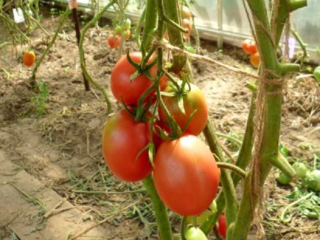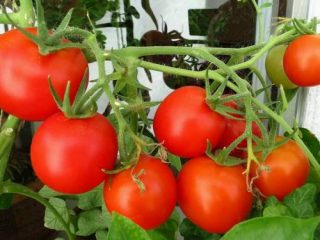Content
Varieties of large-fruited tomatoes are often of interest to gardeners. Giving preference to one or another tomato, vegetable growers pay attention to yield, taste and color of the pulp. Taking into account all these characteristics, the Raspberry Giant tomato, bred by domestic breeders, is very popular. The Sedek agricultural company holds a patent for the variety.
Main characteristics
When starting to consider the description of the Raspberry Giant tomato, you need to consider that there is also a hybrid with a similar name. The Crimson Giant F1 has slightly different characteristics from its relative. The hybrid is resistant to negative weather conditions and diseases, and produces larger fruits with a better taste of the pulp. However, such a crop requires painstaking care, and seeds cannot be collected from the fruits for propagation.
Returning to the characteristics and description of the Raspberry Giant tomato variety, we note that the culture is determinant. The bush does not belong to the standard type.
The determinate tomato variety Raspberry Giant is characterized by a developed bush that can grow from 0.5 to 1 m in height. Typically, in home gardens, crop growth is limited to 0.7 m. The root system is highly developed.It doesn't grow deep. The roots spread under a thin layer of soil and grow far to the side. The foliage shape is normal, like all tomatoes. Color – rich green. There is no pubescence on the foliage, but slight wrinkles are observed. A bush can produce up to 12 clusters. In structure they belong to the fan type.
The inflorescences of the Raspberry Giant tomato are of an intermediate type. They begin to form above the fifth or sixth leaf. The subsequent order of inflorescences is every two leaves. Tomatoes hold tightly on the stalk and do not fall off when ripe. The fruits are resistant to severe cracking. There are few seeds in the pulp.
According to the time of ripening, tomatoes of the Raspberry Gigant variety are considered early ripening. The first harvest is ready for consumption three months after massive seed germination has occurred. Due to early ripening, tomatoes of this variety do not have time to be affected by late blight. The harvest is harvested even before the period when night and day temperatures begin to fluctuate. The variety is excellent for growing in the garden. To protect against spring frosts, tomatoes are covered with film. Tomato adapts well in a greenhouse. The productivity of the variety is high. With good care, you can remove more than 6 kg of tomatoes from a bush. At 1 m2 plant up to three bushes, collecting about 18 kg of tomatoes from them.
Fetal characteristics
The shape of the Crimson Giant fruit is round and uneven. The tomato is flattened on top and bottom, and there is a faint ribbing coming from the stalk. The tomato has a good presentation. The fruits grow almost the same size with an average diameter of 10 cm. The normal weight of a ripe tomato is from 200 to 400 g. Sometimes larger specimens grow on the lower tier.
The skin of tomatoes is thin, but dense, and therefore resistant to cracking. Unripe fruits are characterized by a green color with a pale tint. A dark green spot is observed near the stalk. When ripe, the fruit first turns pink and then acquires a crimson color. The fleshy pulp is highly saturated with juice. The structure is characterized by medium density. The seeds are collected in four chambers. There may be more of them, but there are still few grains.
In general, reviews from gardeners about the Raspberry Giant tomato are very good. Tomatoes can withstand long-term transportation. The harvest can be stored, but the basement needs to be dry, dark and ventilated. It is important to maintain room temperature during storage and not allow it to fluctuate.
Vegetable growers focus on the tasty sweet pulp with a faint sour taste. The tomato does not pose a danger to allergy sufferers and is suitable for preparing baby food and diet food.
Tomatoes are suitable for any type of processing, but not for canning. The fruits are quite large and they simply will not fit into the jar. However, housewives manage to preserve them in slices and add them to vegetable salads. Tomato is delicious fresh. It is usually used for salads. The fruit is characterized by a fleshy structure. Because of this, it is excellent for making ketchup, pasta, and juice.
Features of growing large-fruited tomato varieties
The culture loves fertile soil and a well-ventilated area in the garden, but without drafts. This variety of tomatoes is recommended to be grown in open ground in the southern regions. For other areas, it is advisable to place the crop in a greenhouse or at least under a film cover.
Raspberry Giant is a varietal tomato. This allows the vegetable grower to independently propagate from seeds. The time for sowing seedlings is different for each region, but usually it occurs in March. It is convenient to sow grains in plastic cups or boxes. The seedlings are moistened with a spray bottle, provided with daylight, ventilated and at the initial stage maintained at a constant temperature.
Grown plants are planted in separate cups. Be sure to fertilize the seedlings to feed them, and when they grow up, they begin to harden them. Before planting, the plants are accustomed to the outside temperature. First, the tomatoes are placed in the shade, and then moved to the sun. Before planting seedlings, add a little ash and superphosphate to the ground. The root of the plant is covered with soil up to the cotyledon leaves. This makes them develop better, become branched and grow to the sides.
Studying photo reviews of the yield of the Raspberry Giant tomato, we can conclude that this variety is excellent for growing in any region. However, it is important to pay attention to one detail here. Breeders recognized the tomato variety as an early ripening crop. However, fruit ripening can take up to 110 days. This gives the right to classify the variety closer to mid-early tomatoes. There are reviews about the Raspberry Giant tomato variety that talk about harvesting in early September.For the northern regions, such a period is unacceptable, which is why they are recommended to be planted in a greenhouse.
Tomato is a determinate variety, but the plant requires a stepson. Good results can be obtained by forming a crop of 1 or 2 stems. Stepping allows you to get larger tomatoes, plus their ripening time is accelerated. The leaves of the lower tier are removed from the plant, although this requirement must be observed for tomatoes of all varieties.
Reviews from gardeners include their personal observations. The issue of common diseases comes up very often. So, the variety is characterized by resistance to blossom end rot. Culture rarely suffers from this disease. But cladosporiosis and late blight during the epidemic affect the crop along with other varieties of tomatoes, although breeders claim resistance to these diseases.
The video talks about growing tomatoes:
When growing this tomato variety, you must follow a number of rules related to crop care:
- The variety is considered determinate, but vigorous. Tomatoes are planted at intervals to ensure easy access to them.
- The presence of a trellis is required. Even if the bush does not grow higher than 70 cm, the stem will not support the weight of large fruits and will fall to the ground.
- During pinching, shoots that appear in the axils of the main leaves are removed. It should be taken into account that this procedure is not one-time, but regular. The lower tier of foliage is removed down to the first brush.
- To get a normal yield on a plant, you need to normalize the ovary. It is optimal to leave no more than five fruits in each cluster.
- During the entire growing season, tomatoes are weeded. It is advisable to water at the root. Organic fertilizing and mineral fertilizers will help grow large fruits.Even if there is no epidemic, preventive spraying with fungicides always remains relevant.
Reviews
In general, growing the Raspberry Giant and caring for the crop is practically no different from other varieties of determinate tomatoes. Now let’s take a look at the reviews of vegetable growers who have had this large-fruited tomato growing in their garden for many years.














